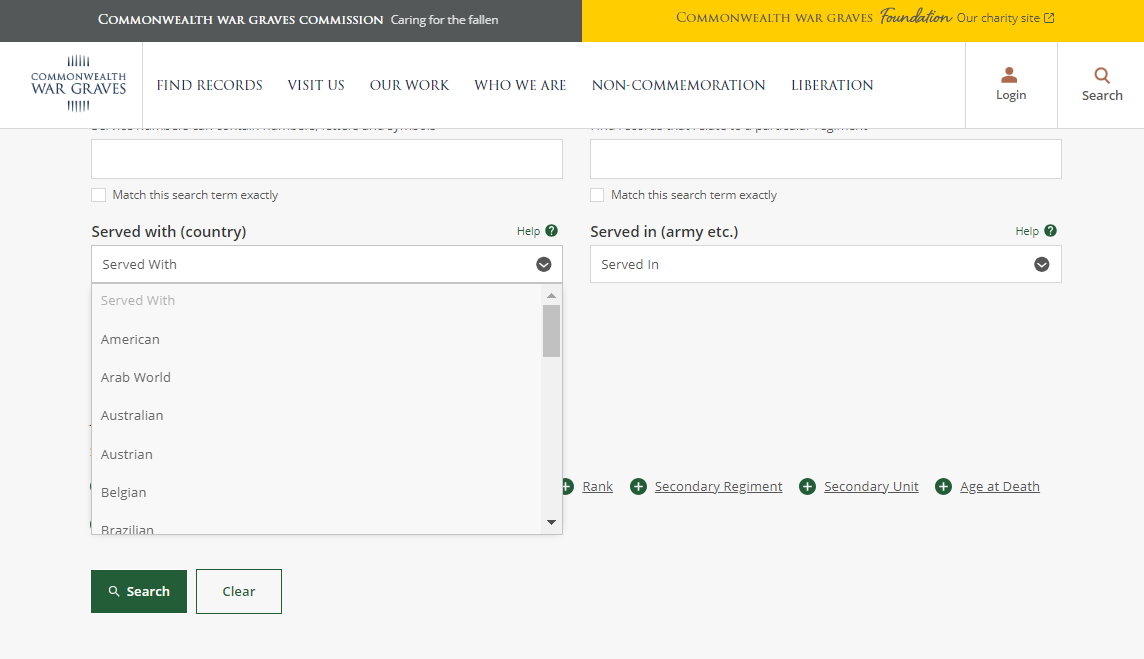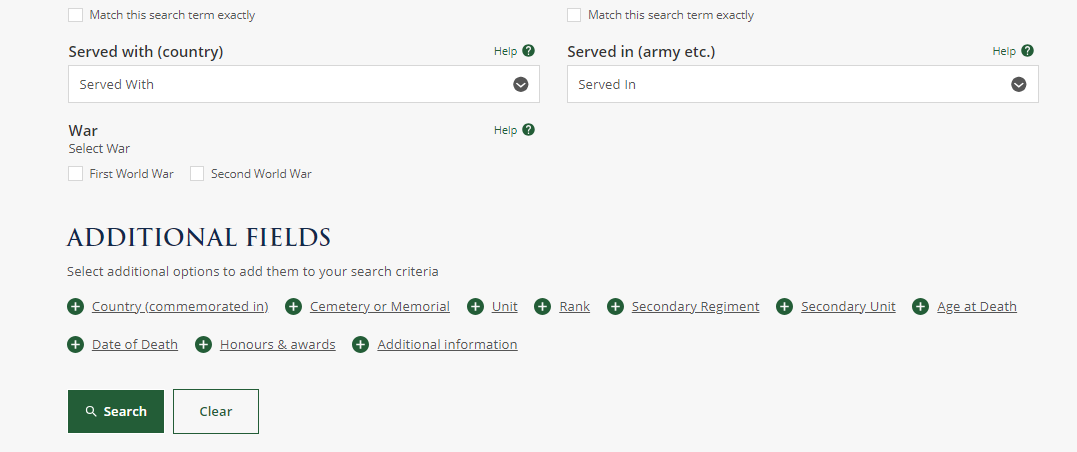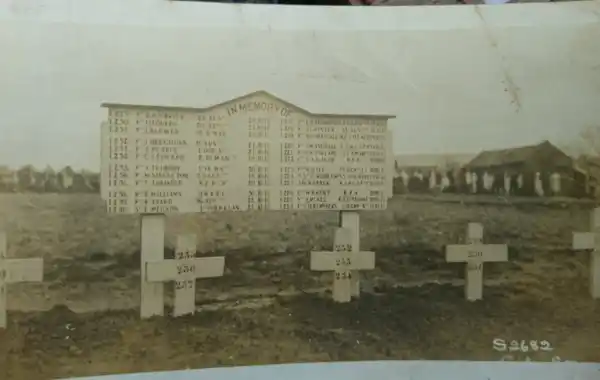Discover how to use the Commonwealth War Graves Commission free online database. Learn how to trace someone who died in the war (First World War and Second World War military and Second World War civilian casualties of war included).
- How to trace someone who died in the First or Second World War
- Where to search for someone who died in the war
- Whose WW2 graves does the Commonwealth War Graves Commission include?
- Guide to the Commonwealth War Graves Commission
- How did the Commonwealth War Graves Commission begin?
- Why was the Commonwealth War Graves Commission founded?
- How were the First World War graves established?
- Who works for the Commonwealth War Graves Commission?
- How are the remains of soldiers of the World Wars identified?
- Visiting information for the Commonwealth War Graves Experience
- Visiting information for the Commonwealth War Graves Commission Archives
How to trace someone who died in the First or Second World War
The Commonwealth War Graves Commission provides a free online searchable database in which you can search for Commonwealth personnel who died in 153 countries as a result of enemy action in the First and Second World Wars. Note that the 68,000 Commonwealth civilians of the Second World War are included in the database.
1. Where to search for someone who died in the war
Go to the Commonwealth War Graves Commission free online 'Find War Dead' database: https://www.cwgc.org/find-records/find-war-dead/

2. Explore the drop-down CWGC menus
This is the easiest way to gain an idea of whether your ancestor may have been included. Note that more than 20 different countries are included in the 'Served with (country)' field.
- Note too that you can narrow your search, specifying whether the person you are researching served with the Army, Navy, Air Force, Merchant Navy or was a Second World War civilian.
- Note that the majority of the 68,000 civilians were registered as having died in the UK (eg as a result of the Blitz), but those who lost their lives on sea voyages as a result of enemy action, may be included, as may those who died as a result of enemy action in other locations, eg from Gibraltar to Sumatra.

3. Don't forget the 'additional fields'
Refine your search of the Commonwealth War Graves Commission 'Find War Dead' database by additional search fields. These allow you to specify, for instance, 'Country (commemorated in)', 'Cemetery or Memorial', 'Age at death', and more.

Whose WW2 graves does the Commonwealth War Graves Commission include? Military historian Simon Fowler explains
In total the Commonwealth War Graves Commission cares for the graves and memorials of 1.7 million people who lost their lives in the First and Second World Wars.
Concentrating on the Second World War, with the 80th anniversary of the final year of the conflict close at hand, the Commonwealth War Graves Commission cares for the graves of nearly 400,000 British men and women who lost their lives between 1939 and 1947, and a further 200,000 graves and memorials for men and women from other Commonwealth countries.
Details of all the casualties are available on the Commission’s website: www.cwgc.org. There is a powerful search engine, which allows users to search by name, place, date, cemetery, or unit. The information given includes exact date of death, and place of burial or memorial where the individual is commemorated.
Make sure you find all the burial clues
It is worth scrolling down to the bottom of the screen containing details of individuals as there are often pages taken from the Commission’s Archives, containing the grave registration details, the wording on the gravestone, and perhaps showing where a man was originally buried. After the war the bodies of many men were moved from their original resting place to larger purpose-built war cemeteries.
Check out The National Archives for correspondence
The National Archives also has investigations into the deaths of service personnel including correspondence with families. Those for the Army are in series WO 361, the RAF in series AIR 81 and the Navy in series ADM 358. Also of interest are the casualty lists available on Findmypast.
Military historian Graham Bandy provides a guide to the Commonwealth War Graves Commission
If you have ever wandered into a village churchyard and seen a rather different gravestone with a military badge on it, chances are you are looking at a CWGC headstone. Graham Bandy takes a look at the work of the Commonwealth War Graves Commission.
You may have been to France and Flanders or one of the 23,000 war cemeteries in over 150 countries, and seen the beautifully-cared-for graves in the many corners of many a foreign field.
How did the Commonwealth War Graves Commission begin?
The Commonwealth War Graves Commission (CWGC) was founded as the Imperial War Graves Commission (IWGC) in 1917 by Royal Charter.
Sir Vivian Ware was the main driving force behind it, along with several others including Rudyard Kipling who wrote the epitaphs for the memorials, including “Their name liveth for evermore” and “Known unto God” which is seen on the many “unknown” graves. He of course lost his son Jack in 1915, and he was only recently identified.
Why was the Commonwealth War Graves Commission founded?
The IWGC was the result of a question that haunted the government of the time. What to do with the bodies of the ever mounting dead from the battlefields of The Great War?
.jpg)
For millennia, battles have been fought and the bodies of the slain have been left where they fell. In later years they were placed into burial pits on the field of battle, after they had been scavenged and plundered by the victors and the locals.
As time went on, questions of commemoration were raised, and the first memorials to the dead other ranks, rather than just generals and other officers, began to be raised during the second Boer War (1899-1902). This became a “citizens war” where the “weekend warriors” of the Volunteers, and newly raised Imperial Yeomanry from the civilian populace, took to the field alongside the regular forces. There are many towns and parishes that have either a statue to the fallen of the second Boer War or a memorial plaque with names upon, such as this one in the porch of Northampton Guildhall.
.png)
The enormous cost of bringing bodies back from the far-flung corners of empire were of course beyond the capabilities of any government, and thus units, regiments and friends bore the cost of local gravestones and memorials.
Then came The Great War - a war being fought over ground that had seen the victories of Henry V and his men at Agincourt, The Duke of Marlborough's army in the time of Queen Anne, and of course the Allied army under Wellington at Waterloo. This is the fertile soil where the sons of England and the rest of the British Isles had bled for centuries; and they would do so once again.
This time it was different, instead of the tens of thousands of fighting men there were millions on each side. Technology had advanced, and tens of thousands could become casualties in one day.
How were the First World War graves established?
The dead from the early battles were quickly lain in village cemeteries to start with, and then battlefield graves. As time went on, the number of cemeteries began to grow around the Casualty Clearing Stations and Field Hospitals.
And so it was, that in 1917 the scene was set for the birth of the Imperial War Graves Commission.
The graves were initially marked by simple wooden crosses, some of which survive in a number of parish churches around the country. The pre-eminent architect of the time, Sir Edwin Lutyens, began to draw up the master plan alongside other eminent architects for these sites. He worked alongside his horticultural partner, Gertrude Jekyll to plan for the planting of the cemeteries too. It is he that is responsible for the “cross of sacrifice” markers in all of the cemeteries, as well as the edifices that stand to name the 320,000 that still have no known grave.
Who works for the Commonwealth War Graves Commission?
The care of the graves and memorials is now a huge responsibility, and the CWGC (renamed in 1960) employ their own staff, and gardeners in this work. Up until quite recently, you may have only seen a gardener or two tending the soil or cutting the grass in these walled gardens of remembrance, and that was probably all one knew of this highly-skilled organisation. For not only do they employ over 850 gardeners, but also blacksmiths, carpenters, and stonemasons amongst the 1,300 strong workforce.
The work of these “back-room boys” (and indeed girls) can now be explored at the CWGC Experience just to the south of Arras in Northern France. It is from here that all the work is undertaken and co-ordinated alongside head office in Maidenhead. You can now see the remaking of metal and wooden gates, the casting of bronze swords of sacrifice, the making of the iconic CWGC signs, the skilled lathe turning of finials and the important stone cutting, which is done both by hand and by four modern “pantograph” machines. These can cut any name and regimental badge in a shorter time, and thus each machine can produce up to five finished memorials a day.
How are the remains of soldiers of the World Wars identified?
As many as 40 bodies a year are recovered by the team at Arras, and depending upon the soil status there can be few remains or, a surprising amount for identification, from boots and uniforms, through web and leather equipment to even a still knotted silk tie that was recently found in a battlefield grave. If a Northamptonshire Regiment badge is found alongside some other effects, it may be possible to tie down a unit to that location and a particular date. If other identification is found, such as a bracelet or other named items (yes, they can still be found intact!), then an almost positive ID can be made.
These fallen are not always DNA tested, but if some ideation of as to who the remains are of, it can be done to trace relatives. [As for instance in the Fromelles Project, of which Family Tree DNA Bootcamp tutor Michelle Leonard was a researcher].
Visiting information for the Commonwealth War Graves Experience
The centre is open Monday to Friday from 1000hrs until 1600hrs
Commonwealth War Graves Experience
5-7 Rue Angele Richard
62217
Beaurains
France
Visiting information for the Commonwealth War Graves Commission Archives
The Reading Room is open Mondays to Thursdays, 10am to 4.30pm.
To book your appointment, contact [email protected]
Post last updated 4 November 2024.








